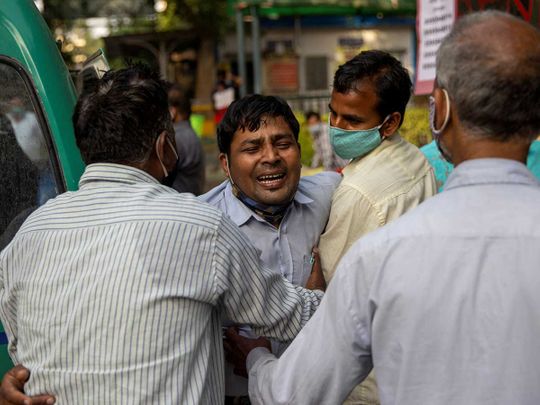
I woke up this morning with death knocking at my door. Alas, the second surge of the Covid-19 pandemic has finally struck the Indian Institute of Advanced Study (IIAS), where I am Director. Our Accounts Assistant, Ramesh Chand, passed away at the Indira Gandhi Medical College Hospital at 2:31am. He was close to 59. Next year, he would have retired after serving the Institute for over 30 years.
True, employees, fellows, and members of our extended IIAS family had contracted Covid-19 in the past. But that was last year, during the first wave. Except one, all of them had recovered, with symptoms more or less severe. The sole exception was Dr Vijaya Ramaswamy, our Tagore Fellow, whom we lost last year on 1 June.
But her sad demise had not happened on our watch. Vijaya had left for Delhi after the first lockdown in March 2020, thinking she could get better care in the national capital. When she caught Covid-19, the world was quite far from inventing vaccines against the virus. The fear of infection was so high that she found it difficult to be admitted in a hospital. Moreover, she was severely asthmatic. She passed away literally gasping for air.
Double mutant strain
We knew then that the novel coronavirus was not to be taken lightly. Those it infected took months to get back to normal. But now, in this its second wave, new variants of the virus are wreaking disease and death in a much more stealthy and lethal manner. The pandemic has penetrated into spaces thought to be safer. The so-called double mutant strain has defied containment measures and gone to far-flung places.
Such as IIAS, Shimla. Located in the salubrious environs of the former Viceregal Lodge, which served as the summer capital of British India, the Institute nestles in the lower Himalayas, at an elevation of nearly 7500ft above sea level. Even during colonial times, our erstwhile rulers chose this spot because they believed it was healthy and hygienic compared to the plains, which were afflicted with cholera, typhoid, malaria, and a variety of tropical ailments.
As the famous Himalayan explorer and major in the East India Company army, Sir William Lloyd, exclaimed on reaching ‘Semla’ on 6 May 1821, “the mountain air seemed to have instilled ether into my veins, and I felt as if I could have bounded headlong down into the deepest glens, or sprang nimbly up their abrupt sides with daring ease” (Edward Buck, Simla Past and Present). Indeed, throughout the outbreak of the current pandemic, the caseload as well as fatality rates were much lower here than the plains. But now, the wily and deadly virus has claimed its first casualty in our very midst.
When death comes to our doorstep, no amount of distraction or dodging can shield us from its impact or damage. There is no diversion or defence against its dire and deathly stranglehold. When it comes to the current pandemic, we find ourselves gasping and, in the end, left literally out of breath. Dead.
Even before the Himachal Pradesh State Government’s curfew orders, we had decided to close down the Institute and work from home. We were most keen to break the chain of infection. Given that the rate of testing is both low and slow, during the first wave, too, we had closed the Institute for a few days and sanitised the premises when any of our colleagues had tested positive.
But Ramesh Chand’s death has taken our crisis to an unprecedented level. What I most remember of him is his smiling face and the hat, which he always had on. Unfortunately, despite reminders and prompting, he had failed to take his first vaccine shot when he became eligible.
Encouraging vaccinations by all
I hope that our strategy of encouraging vaccinations by all those eligible, closing down the Institute, plus ensuring adequate distancing will prevent more fatalities. But what of those already infected? Many carriers are asymptomatic and with inadequate testing, short supply of oxygen, and scarcity of hospital beds, the situation even so high up in the Himalayas, looks pretty grim if not catastrophic.
Down below, in our megacities in the plains, a tragic, even apocalyptic, scenario is unfolding. Notwithstanding the lurid “cremation-porn” style of reporting that even some established and respected media houses have indulged in, the evidence on the ground shows some severe misjudgements and lapses.
Most obviously, the severity of the second wave of the pandemic was neither anticipated nor prepared for. Instead, we believed that India had gotten the better of the virus. How wrong were we, leaders and citizens alike.
The two gravest consequences were vaccine mismanagement and a breakdown in oxygen supplies. India exported 6.6 million doses of vaccines which could have saved precious lives had they been administered locally. As to the shortage of oxygen, thousands of lives have been lost because of it. What is ironic is that India is among the world’s largest producers of oxygen.
Now the Supreme Court has itself stepped in to set up a National Task Force to regulate oxygen allocation. A ramp-up in vaccine production and distribution is also underway. If I were to look at the positive side, at least we are much better primed for a third wave. But I pray that that is not needed and the third wave is prevented from striking us. The country and its people are saturated to bursting point with suffering, disease, and death.











